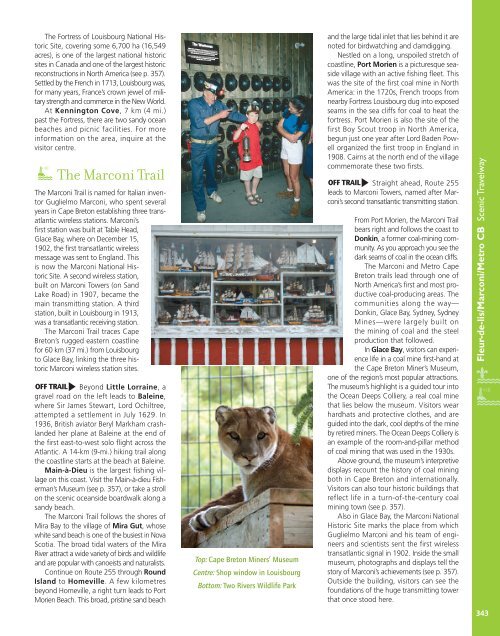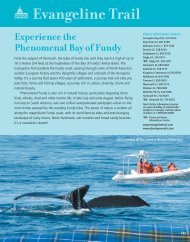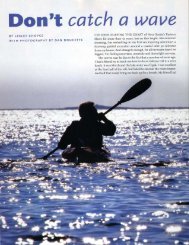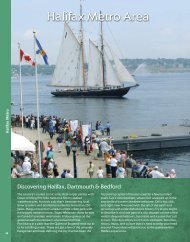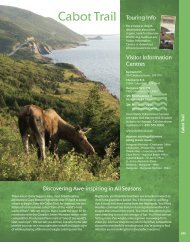Download more about Fleur de lis/Marconi/Metro CB - Nova Scotia
Download more about Fleur de lis/Marconi/Metro CB - Nova Scotia
Download more about Fleur de lis/Marconi/Metro CB - Nova Scotia
You also want an ePaper? Increase the reach of your titles
YUMPU automatically turns print PDFs into web optimized ePapers that Google loves.
The Fortress of Louisbourg National Historic<br />
Site, covering some 6,700 ha (16,549<br />
acres), is one of the largest national historic<br />
sites in Canada and one of the largest historic<br />
reconstructions in North America (see p. 357).<br />
Settled by the French in 1713, Louisbourg was,<br />
for many years, France’s crown jewel of military<br />
strength and commerce in the New World.<br />
At Kennington Cove, 7 km (4 mi.)<br />
past the Fortress, there are two sandy ocean<br />
beaches and picnic facilities. For <strong>more</strong><br />
information on the area, inquire at the<br />
visitor centre.<br />
6The <strong>Marconi</strong> Trail<br />
The <strong>Marconi</strong> Trail is named for Italian inventor<br />
Guglielmo <strong>Marconi</strong>, who spent several<br />
years in Cape Breton estab<strong>lis</strong>hing three transatlantic<br />
wireless stations. <strong>Marconi</strong>’s<br />
first station was built at Table Head,<br />
Glace Bay, where on December 15,<br />
1902, the first transatlantic wireless<br />
message was sent to England. This<br />
is now the <strong>Marconi</strong> National Historic<br />
Site. A second wireless station,<br />
built on <strong>Marconi</strong> Towers (on Sand<br />
Lake Road) in 1907, became the<br />
main transmitting station. A third<br />
station, built in Louisbourg in 1913,<br />
was a transatlantic receiving station.<br />
The <strong>Marconi</strong> Trail traces Cape<br />
Breton’s rugged eastern coastline<br />
for 60 km (37 mi.) from Louisbourg<br />
to Glace Bay, linking the three historic<br />
<strong>Marconi</strong> wireless station sites.<br />
Beyond Little Lorraine, a<br />
gravel road on the left leads to Baleine,<br />
where Sir James Stewart, Lord Ochiltree,<br />
attempted a settlement in July 1629. In<br />
1936, British aviator Beryl Markham crashlan<strong>de</strong>d<br />
her plane at Baleine at the end of<br />
the first east-to-west solo flight across the<br />
Atlantic. A 14-km (9-mi.) hiking trail along<br />
the coastline starts at the beach at Baleine.<br />
Main-à-Dieu is the largest fishing village<br />
on this coast. Visit the Main-à-dieu Fisherman’s<br />
Museum (see p. 357), or take a stroll<br />
on the scenic oceansi<strong>de</strong> boardwalk along a<br />
sandy beach.<br />
The <strong>Marconi</strong> Trail follows the shores of<br />
Mira Bay to the village of Mira Gut, whose<br />
white sand beach is one of the busiest in <strong>Nova</strong><br />
<strong>Scotia</strong>. The broad tidal waters of the Mira<br />
River attract a wi<strong>de</strong> variety of birds and wildlife<br />
and are popular with canoeists and natura<strong>lis</strong>ts.<br />
Continue on Route 255 through Round<br />
Island to Homeville. A few kilometres<br />
beyond Homeville, a right turn leads to Port<br />
Morien Beach. This broad, pristine sand beach<br />
Top: Cape Breton Miners’ Museum<br />
Centre: Shop window in Louisbourg<br />
Bottom: Two Rivers Wildlife Park<br />
and the large tidal inlet that lies behind it are<br />
noted for birdwatching and clamdigging.<br />
Nestled on a long, unspoiled stretch of<br />
coastline, Port Morien is a picturesque seasi<strong>de</strong><br />
village with an active fishing fleet. This<br />
was the site of the first coal mine in North<br />
America: in the 1720s, French troops from<br />
nearby Fortress Louisbourg dug into exposed<br />
seams in the sea cliffs for coal to heat the<br />
fortress. Port Morien is also the site of the<br />
first Boy Scout troop in North America,<br />
begun just one year after Lord Ba<strong>de</strong>n Powell<br />
organized the first troop in England in<br />
1908. Cairns at the north end of the village<br />
commemorate these two firsts.<br />
Straight ahead, Route 255<br />
leads to <strong>Marconi</strong> Towers, named after <strong>Marconi</strong>’s<br />
second transatlantic transmitting station.<br />
From Port Morien, the <strong>Marconi</strong> Trail<br />
bears right and follows the coast to<br />
Donkin, a former coal-mining community.<br />
As you approach you see the<br />
dark seams of coal in the ocean cliffs.<br />
The <strong>Marconi</strong> and <strong>Metro</strong> Cape<br />
Breton trails lead through one of<br />
North America’s first and most productive<br />
coal-producing areas. The<br />
communities along the way—<br />
Donkin, Glace Bay, Sydney, Sydney<br />
Mines—were largely built on<br />
the mining of coal and the steel<br />
production that followed.<br />
In Glace Bay, visitors can experience<br />
life in a coal mine first-hand at<br />
the Cape Breton Miner’s Museum,<br />
one of the region’s most popular attractions.<br />
The museum’s highlight is a gui<strong>de</strong>d tour into<br />
the Ocean Deeps Colliery, a real coal mine<br />
that lies below the museum. Visitors wear<br />
hardhats and protective clothes, and are<br />
gui<strong>de</strong>d into the dark, cool <strong>de</strong>pths of the mine<br />
by retired miners. The Ocean Deeps Colliery is<br />
an example of the room-and-pillar method<br />
of coal mining that was used in the 1930s.<br />
Above ground, the museum’s interpretive<br />
displays recount the history of coal mining<br />
both in Cape Breton and internationally.<br />
Visitors can also tour historic buildings that<br />
reflect life in a turn-of-the-century coal<br />
mining town (see p. 357).<br />
Also in Glace Bay, the <strong>Marconi</strong> National<br />
Historic Site marks the place from which<br />
Guglielmo <strong>Marconi</strong> and his team of engineers<br />
and scientists sent the first wireless<br />
transatlantic signal in 1902. Insi<strong>de</strong> the small<br />
museum, photographs and displays tell the<br />
story of <strong>Marconi</strong>’s achievements (see p. 357).<br />
Outsi<strong>de</strong> the building, visitors can see the<br />
foundations of the huge transmitting tower<br />
that once stood here.<br />
<strong>Fleur</strong>-<strong>de</strong>-<strong>lis</strong>/<strong>Marconi</strong>/<strong>Metro</strong> <strong>CB</strong> Scenic Travelway<br />
343


